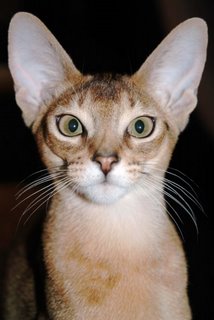Cinnamon genes

Cold Spring Harbor Laboratory: Embargoed for release: 31- Cinnamon genes The cat genome has been sequenced for the first time. Scientists used samples taken from a four- Cinnamon is one of several mammals now being studied using a new method called light genome sequencing. The research team started with Cinnamon’s raw sequence data. Then scientists at a number of centres worked together. They used information from the genomes of other mammals that had been sequenced, together with earlier studies of the cat. Six other mammal genomes have recently been completed. They are the human, chimpanzee, mouse, rat, dog, and cow. The human genome was finally sequenced in February 2001. Similarities between the cat genome and these six let the scientists identify 20,285 possible cat genes. They found hundreds of rearrangements within the chromosomes. These took place among the different mammals since they evolved from their common ancestor. This ancestor roamed the earth among the dinosaurs around 100 million years ago. This latest research is expected to lead to health benefits for domestic cats. Ninety million are owned by Americans alone, according to The Humane Society. But the domestic cat is also a good model for human disease. This is why the National Human Genome Research Institute authorised the cat genome project three years ago. Domestic cats can suffer from over 250 hereditary diseases. Many of these are like genetic diseases in humans. Cinnamon has a mutation, for example, that causes retinitis pigmentosa. This is an eye disease that can lead to blindness. In humans, retinitis pigmentosa affects 1 in 3,500 Americans. The cat is also a good model for human infectious diseases such as HIV/AIDS. Feline immunodeficiency virus (FIV) is a relative of human immunodeficiency virus (HIV), which causes AIDS. Using the cat genome data, the researchers identified several hundred thousand variants in the genes (known as SNPs, DIPs, and STRs). These can be used to discover the genes that cause hereditary diseases in cats and humans. The scientists have already used these variants to identify the gene that causes Cinnamon’s retinitis pigmentosa. They published a paper on this in the May/June, 2007 issue of the Journal of Heredity. These gene variants will also be useful for parentage testing, forensic analysis and studies of evolution. They will shed light on how the cat was domesticated. They will provide information on the development of fancy breeds. They will tell scientists how the great roaring cats have adapted to their environment. The researchers also analysed the cat genome for interesting features, such as fragments of genes that migrated to the chromosomes from the mitochondria. They also looked at a sea of repeating patterns that don't seem to do much. These included scores of genomic stretches from historic retroviruses. Some of these have known links to cancer. The Cat Genome Project is based at the National Cancer Institute (Frederick, Md.). Cinnamon lives in a cat colony at the University of Missouri- More help with words cell conception conference DNA environment evolution fertilisation individual inherit journal molecule protein RNA species sperm structure What's it all about? More science teaching resources for this story
Topic for discussion, research or pupil presentations
Here are a few of the issues, implications and applications extracted from the cat genome research story: Tips for science class discussions and groupwork No 63 It is a shame that more scientists don't read the education literature, for they would be aware of the quiet revolution taking place in teaching.... Put students into small interactive groups of four or five, give them projects, problems, tests, or case studies to analyze, and they will learn more effectively. Unlike many fads in education, which are enthusiastically touted but poorly investigated, cooperative learning may be the most thoroughly studied educational technique ever utilized. ... Cooperative learning promoted higher individual knowledge than did competitive and individualistic learning, whether the task required verbal, mathematical, or physical skills. Most important the retention of knowledge was greater. Cooperative learning has striking additional benefits..." Herreid, C.F. (2007) Start with a Story: The Case Study Method of Teaching College Science. Arlington, Virginia: NSTA Press
Here are a few of the group research and/or discussion topics arising from the above. No doubt you will be able to think of others yourself.

0 Comments:
Post a Comment
<$I18N$LinksToThisPost>:
Create a Link
<< Home